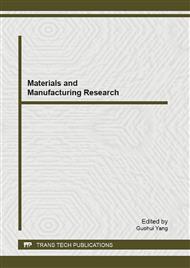p.169
p.174
p.178
p.182
p.188
p.194
p.198
p.202
p.209
Residual Stress Profile of Ultra High Strength Low Alloy Steel Induced by High Speed Milling Process
Abstract:
In order to improve the surface quality of ultra high strength low alloy steel work-pieces produced by high-speed face milling process, 23-1 factorial design experiment was con-ducted and the residual stress profiles within the surface and subsurface layer of work-pieces were measured. Corresponding empirical models for the residual stress profile were presented and the effects of cutting parameters (cutting velocity, feed per tooth, depth of cut) on characteristics of the residual stress profile were studied. Results show that: with the range of cutting parameters tested, the compressive residual stress profile would be induced below the work-pieces’ surfaces machined by high speed face milling process. Feed per tooth has the critical influence on the characteristics of the compressive stress profile, and the mechanism of residual stress generation will be different when feed per tooth changes in high speed machining process. To obtain higher compressive stress and deeper compressive stress profile depth, larger feed rate and depth of cut are required.
Info:
Periodical:
Pages:
188-193
Citation:
Online since:
January 2013
Authors:
Price:
Сopyright:
© 2013 Trans Tech Publications Ltd. All Rights Reserved
Share:
Citation:


